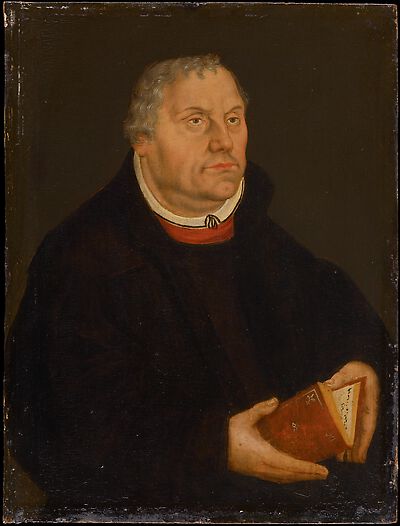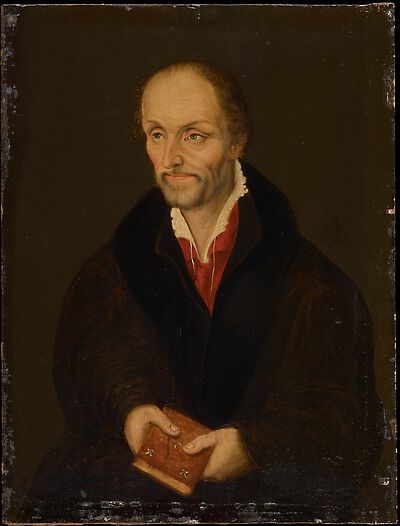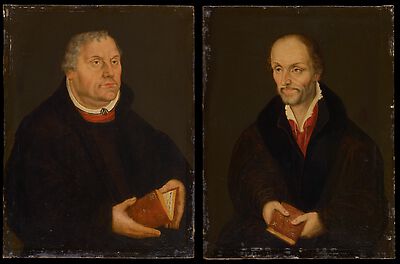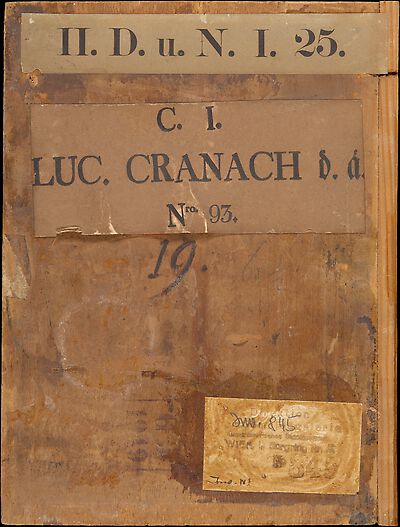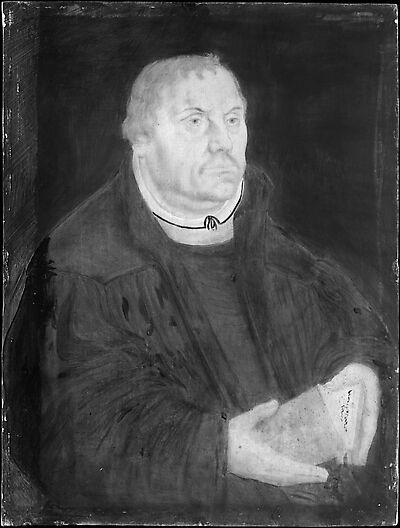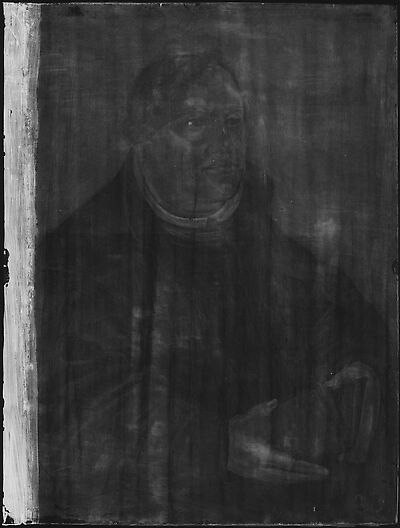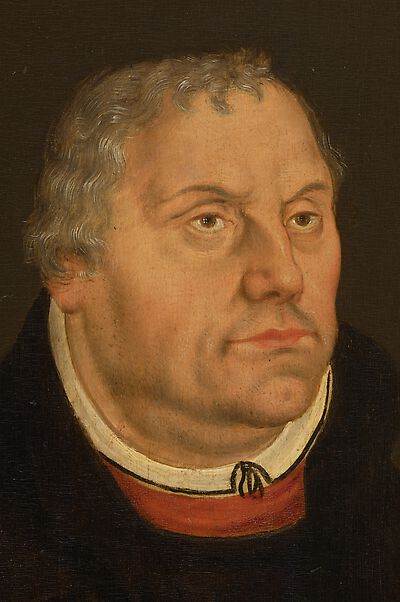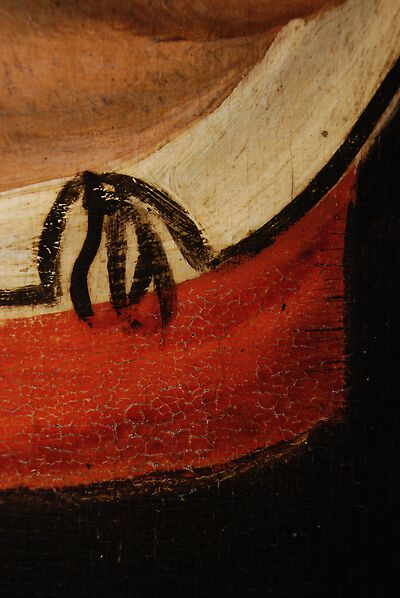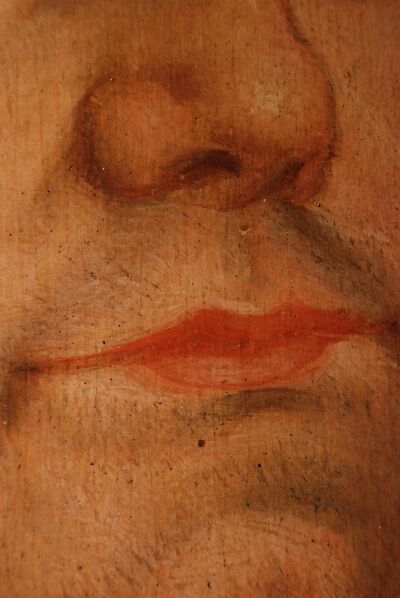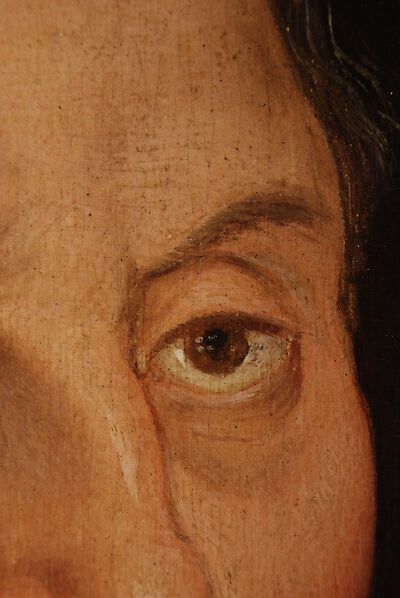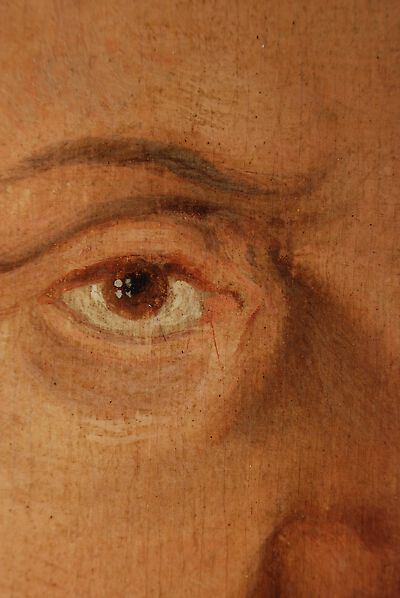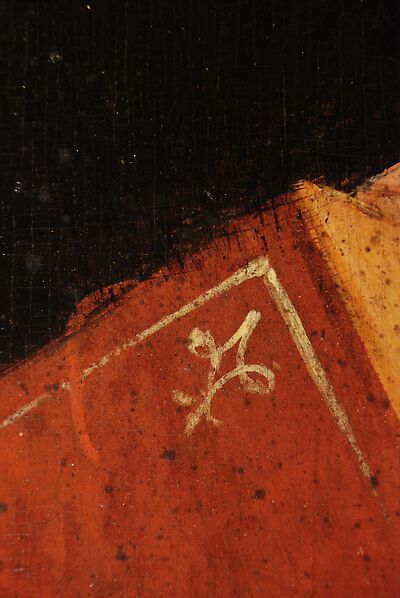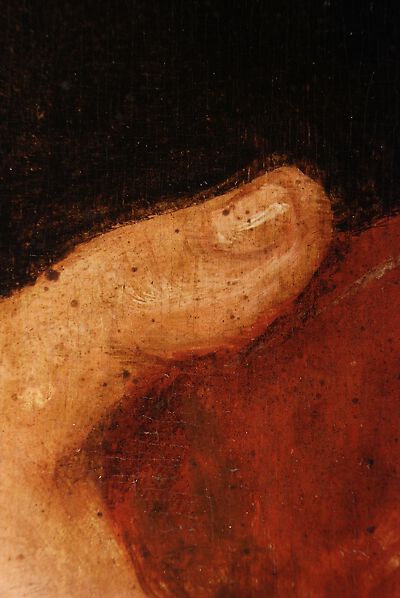As early as 1532/33 the workshop of Lucas Cranach the Elder created a great number of double portraits of Martin Luther and Philipp Melanchthon (compare with the double portrait in Dresden, see [Exhib. Cat. Chemnitz 2005, Nos. 42.1, 42.2]. The portraits of the Reformers in the KHM are also small formats and differ primarily in the seniority of the sitters. Lucas Cranach the Younger also made recourse to a traditional type, which he already employed in the double portrait of Martin Luther and Philipp Melanchthon, dated 1559 and now in the Städel-Museum in Frankfurt [Cat. Frankfurt 2011, Inv. Nr. 2320 und Inv. Nr. SG349]. Dieter Koepplin refers to numerous portraits of ‚Martin Luther‘ and ‚Philipp Melanchthon‘, which were created in Lucas Cranach the Younger’s workshop in the years between 1570/80 [Koepplin, Exhib. Cat. Basel 1974, Bd. 2, 718-719]. It is possible that the dating and attribution of the paintings in Vienna 'after Lucas Cranach the Younger, about 1570/80', were based on these considerations.
Comparative examples from the oeuvre of Lucas Cranach the Younger cited here show both Luther and Melanchthon each with an open book, the content of which is legible for the viewer. As such there is also a content-related reference to the sitters‘ reformation efforts, whereas the paintings in Vienna offer no such reference. The dark background presumably covers an originally lighter, grey background, comparable with the other cited portraits by Lucas Cranach the Younger (see technical examination).
The closed book in Melanchthon’s hands underlines the anatomical discrepancies of the shoulders, arms and hands. Execution of the somewhat more corpulent figure of Martin Luther would have presented the artist with fewer problems.
Representations in illustrated bibles from about 1560 [Troschke 1939, 15-28, Fig. 6, Philipp Melanchthon] as well as the woodcut from the year of Melanchthons death 1560 [Hollstein, Cat. Frankfurt 2011, 49] show the prevalence of this portrait type in other media. Furthermore in the year of Martin Luther’s death Cranach the Younger published a small woodcut after the archetypal Luther portraits from 1532/33 [Hofmann 1982, No. 46], [Bartsch 150], [Hollstein, Cat. Frankfurt 2011, 44 1b].
Werner Schade’s assumption that such portraits served to satisfy the political purpose of dukes and theologians can be applied to the double portrait, which might have been created by a close associate of Cranach the Younger’s workshop and which presumably belonged to the original core of the imperial collection. As such not the characteristic portrait representation, but the reference to established forms gained priority. [Schade 1974, 105].
Originally the small double portrait was conceived as a hinged diptych. Remnants of the embellishment on the reverse as well as traces of an adhesive tape extending over both panels support the presumption, that the panels were once linked and that their versos were visible. (see technical examination). In the mid-18th century, when the double portrait was in the treasury, the paintings were already displayed separately. (see Provenance).
Research history: the collection of the Archduke Leopold Wilhelm is listed in the provenance since Engerth‘s catalogue from 1886, the painting was identified with the accession no. NL 231 [Engerth, Cat. Vienna 1886, Bd. III, 55-56, No. 1486], [Cat. Vienna 1991, 47]
'231. Ein kleines Contrafrait von Öhlfarb auff Holcz des Philippi Melanton in schwartzen Rockh vnndt Huett. In einem schwarcz vnd vergulden Rämel, die Höche 1 Spann vnndt die Braidte 9 Finger. Original von Lucas Crainich. (231. A small portrait oil paint on wood of Philippi Melanton wearing a black robe and hat. In a black and gilded frame, 1 Spann in height and 9 fingers in width. Original by Lucas Crainich)' (source: "Inventarium aller vnndt jeder Ihrer hochfürstlichen Durchleücht Herrn Herrn Leopoldt Wilhelmen [...] zue Wienn vorhandenen Mahllereyen [...]" ehem. Krumau, Fürstl. Schwarzenbergsches Centralarchiv. Published by: [Perger 1883, LXXXVI–CLXXVII]
The description of Philipp Melanchthon with a hat, the absence of the pendant portrait 'Martin Luther' as well as the fact that the height of the described painting including frame is less than that of the panel mitigate against this identification.
In the 18th century inventory of the treasury the unsigned portraits were referred to as paintings by Hans Holbein the Elder, whereas Mechel, who brought them to the Picture Gallery, attributed them to Lucas Cranach the Elder (see Attribution). Schuchardt, who critized the poor condition of the paintings, judged, ‘particularly with respect to the colours‘, them to be more attributable to the Younger Cranach. [Schuchardt 1851, Bd. 2, 140]
Waagen also classified the portraits as 'Fabriksarbeit' (production work) and critized the attribution to the elder Cranach, which did him a grave injustice [Waagen, Cat. Vienna 1866, 162, No. 25]. In the Picture Gallery the double portrait was attributed to school of Cranach from 1886. [Engerth, Cat. Vienna 1886, Bd. III, 55-57, No. 1486, 1487]. Scheibler declared them to be 'schlechte Kopien' (bad copies) after Cranach the Younger [Scheibler 1887, 300-301]. The portraits have not been on display since the reorganization of the Picture gallery in the Kunsthistorische Hofmuseum after 1892.
[Alice Hoppe-Harnoncourt, Kunsthistorisches Museum 2012] [Translation, Smith, cda]
